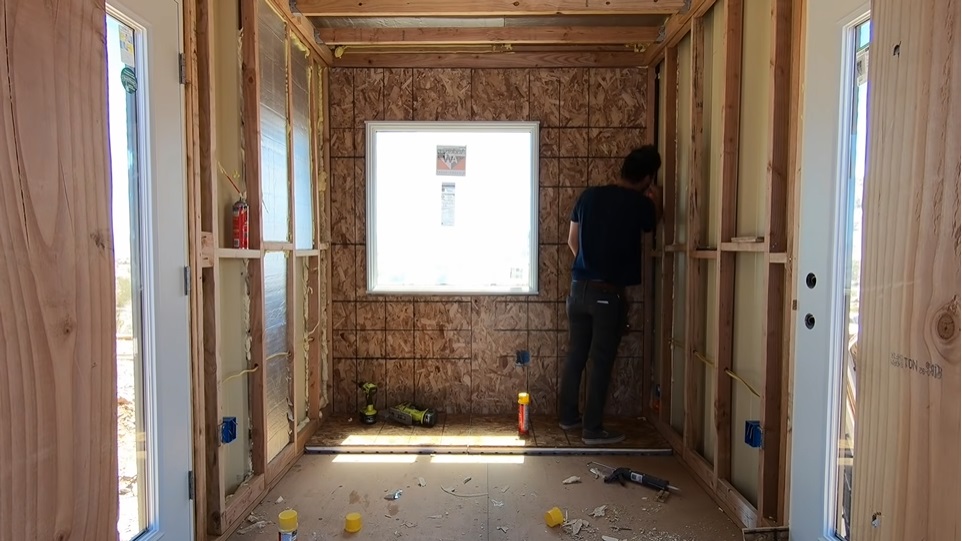Since 2007, when the first US-based shipping container home was designed and built in California, perspective homeowners have been fascinated by the romantic promises of Mortgage Free Living, Cost Effectiveness and Environmental Friendliness offered by builders and other enthusiasts.
A simple Google search of shipping container homes reveals numerous, global examples of unusual, visually stunning examples of what promises to be a “forever home” with no debt. Articles from Curbed to Huffington Post fawn over projects using seductive adjectives such as “coolest thing ever”, “affordable”, “efficient”, and “portable”.
However, this type of flattering coverage fails to accurately report on the true costs and risks pertaining to owning and living in a shipping container. Furthermore, some websites are advocating that building these homes can be a DIY project, when clearly the intricacies and level of construction require professional acumen not appropriate for weekend warriors.
Are Shipping Container Homes a Scam?
A recent public YouTube spat between a Texas-based architectural designer, Belinda Carr, and a Florida-based general contractor, Blake Madgett, motivated us to research the realities surrounding this popular, growing trend.
Widespread interest in shipping container living has been fueled primarily by promises of:
- Cost Savings
- Environmental Friendliness
- Construction Durability
- Speed of Construction
In her video, Carr raised several valid concerns about the benefits often promoted by builders that are used to entice potential homeowners. She also boldly used the term “SCAM” in her video title, which was highly effective at getting the right audience to take part in this warranted discussion.
7 Reasons Why Shipping Container Homes are a SCAM by Belinda Carr
Months after Carr posted her video, Madgett, the building contractor, posted a rebuttal. In our opinion, he appeared to be too distracted and offended by the “S” word and should have focused more on the core issues at hand, by providing hard data to support his responses.
He stated that a scam is when “…somebody is lying to you, promising you something, but the reality is not anywhere close to that”. He continued, while sitting on the steps of a container home, that container homes “…cannot be a scam because I am sitting in front of a container home right now!”
7 Reasons Why Shipping Container Homes are NOT a SCAM by Blake Madgett
It’s our position that consumers need more accurate information to make better informed decisions when considering a shipping container home. We also contend that it is still very early in the evolution of container homes to make the financial commitment or take the risk. Consequently, these types of homes do not yet have a track record of how reliable they may be post 20 years of continuous usage.
Most of the readily available content about shipping container homes focuses solely on the construction and budgeting of container homes. What is lacking is information on the true, long-term durability, reliability and overall homeowner satisfaction of living in this type of space for prolonged periods of time.
Since this is a decision involving actually living in a space, we expressly want to warn potential homeowners to be very objective when considering this type of purchase. Does anyone know how many steel container homes have existed for 25+years, or even better, 50+ years? And if so, what condition are they in? We suspect whatever the numbers may be this is indisputably unchartered waters.
Before providing further reasons to be apprehensive about buying a container home, we now share widely marketed benefits of container homes that continue to help fuel this craze.
The Pros of Shipping Container Homes
Affordability
Proponents of container homes believe that the completion of such homes is a “one and done deal”. By purchasing a shipping container, having it delivered to a desired piece of land and supervising construction, you are rewarded with a fully paid “forever home” that will allow you to live mortgage and rent free.
Advocates believe that these homes are an affordable, living alternative that will allow homeowners to change their lifestyle to preserve finances for higher quality living. Costs to fully realize a habitable container home have been quoted from $10,000 to $50,000.
NOTE: These costs reflect only the purchase, construction and finishing of the shipping container and DO NOT include transport, permits, engineering, or excavation fees for the foundation or the cost of the land where the container home will be placed. See list of all costs here.
Environmental Friendliness
With concern about natural resources and carbon footprints constantly in the news, owners of shipping container homes, the contractors who build them and those with an interest in their promotion, label them as more beneficial to the environment than a traditional structure made of lumber or brick. According to Eco Talk, shipping container homes are “as environmentally friendly as possible“.
Another online website making the case for eco-friendly container homes, states:
“Shipping containers are left abandoned every year. By using them for a dwelling, you’re repurposing steel and giving it a new life. In addition, your recycling cuts down on other materials like concrete or bricks”.
Social Responsibility
Since most of the shipping containers are purchased from brokers who resell “Out of Service” or “End of Life” containers, proponents suggest that saving these steel boxes from a landfill is socially responsible. They include “one-trip” containers in this argument, which is especially important for potential homeowners in California, where ONLY one-trip containers are allowed for residential habitation.
Durability
Since these containers are made of corrugated steel, in many cases COR-TEN Steel, they are touted as being able to withstand extreme weather conditions, such as tornados, hurricanes and earthquakes. There is the belief that steel-framed homes can endure all natural elements and will outlast traditional wood framed or brick homes.
Speed of Build
Contractors and manufacturers of container homes contend that container homes come with pre-built structures, with the frame already in place. By purchasing a steel-framed structure you are purchasing ceiling, walls, and floors. Depending on how you’d like to customize or finish your container, you could be living in your home in a short amount of time.
Manufacturers of pre-built containers are able to maintain consistently shorter build times by having the following advantages: indoor construction unaffected by inclement weather; reduced customization options; and efficient manufacturing processes and sourcing. However the costs of this class of container home are in a significantly higher tier compared to DIY projects.
Flexibility
Supporters of the shipping container movement liken it to the tiny house trend. They suggest that a shipping container is the perfect complement — one container can be as wide as 8 feet. Promoters of this trend state “…it’s easy to drop on a small plot of land, outside of a conventional neighborhood. And if you install solar panels, you’ll be living off-grid”.
Parting Thoughts on the Pros
All this praise, coming from those with vested interests in growing the adoption rate of shipping container housing, may just be the natural result when an innovative trend becomes popular and monetized. Proponents of the container home craze can appear to lack objectivity, especially if shipping containers are the sole method of their residential building business.
Without history and the luxury of time, these advocates may be unknowingly fueling unforeseen housing issues to be encountered only after a large population of these structures have been lived in for 20 years or more. A young track record is the primary reason why we would caution homeowners that may be thinking of using shipping containers for their “forever” homes.
A recent historical example of unforeseen issues originated during the construction boom of 2004-2007 with the use of drywall, also referred to as gypsum-based plasterboard, manufactured in China. As the building industry exhausted locally sourced drywall, unproven and untested substitute material was consequently sourced from China out of necessity.
The Chinese drywall had been found to emit sulfuric gases, which can produce an unpleasant odor, cause corrosion of metals, and inflict health ailments, such as asthma, coughing, headaches, sore throats, and irritated eyes.
The Hype vs. Reality
In keeping with our mission to keep homeowners informed of new trends and to help them make educated decisions, we now present alternate perspectives on these same widely touted benefits of shipping container homes.
The Cons of Shipping Container Homes
Affordability
For years, builders of shipping containers homes have promoted the economic feasibility of building such a structure for human habitation. Unfortunately, what they often fail to disclose is that a modified, purchased steel box will need to be cut for doors and windows, which will always require costly, structural reinforcements.
Although most containers are constructed with COR-TEN Steel, the roof and side walls are made of a lighter gauge material that will reduce the load bearing capacity of the walls and roofs, especially once you begin to cut into the steel for windows, doors and skylights for more natural light.
Since shipping containers are constrained by length and height, usually 40′ X 8.5′ or 9.5′ or 20′ X 8.5′, all designs must be based on these footprints. ALL shipping containers have an external width of 8 feet, with an internal width of 7 feet, 7 inches. Necessary modifications will become rather costly should you require larger widths for your home. Furthermore, as required by law, the container must include insulation, sprinkler systems, mechanical systems, electrical, and plumbing before becoming habitable.
During construction, you lose up to 12″ or one foot off the total height and 6″each from the sides, or a total of one foot from the width, based on local building codes and ordinance requirements. Thus, from one container – you are now reduced to a height of roughly 7’6″ and a width of 6’7″. Now compare these modified dimensions to that of a traditional home where standard hallways are 4 feet wide or to mobile homes which have an average width of 11.5 feet, to get a sense of proportion.
An example of disingenuous information can be found on the site CargoHome, which states that they can build an affordable shipping container home for $42,000. The company does disclose that the home would be a “very basic, no-frills 20′ container home”. However, the reality of this pitch is that by factoring in the square footage lost from construction, you would have a container that is closer to 19′ X 6’7″ or 125 square feet of living space.
This “minor” adjustment in the numbers would equate to a 22% smaller space (125 vs. 160) that equates to 28% higher cost-per-square-foot ($336 vs. $263), e.g.:
- Perimeter of the Structure
- 20’ Long X 8’ Wide Dimensions
- 160 Square Feet
- $42,000 Cost
- $263 Cost-Per-Square-Foot ($42,000 / 160)
- Modified Internal Living Space
- 19’ Long X 6’7″ Wide Dimensions
- 125 Square Feet
- $42,000 Cost
- $336 Cost-Per-Square-Foot ($42,000 / 125)
Keep in mind, this price does not include the cost of the land where you will need to excavate and build your foundation, as required by local law. Conversely, at $316 per square foot, you can search real estate listings and find larger, traditionally built homes with more basic features and amenities.
It is only fair, however, to point out that most builders of container homes, not just CargoHome, state the square footage as the perimeter of the structure and not the modified internal living space. Remember this point when comparing the cost-per-square-foot metric to traditional homes.
Is an Indoor Toilet a Necessity?
Perhaps the most egregious example of the cost efficiencies argument of container homes is found in a comment by Joseph Dupuis of Ottawa, Canada who stated in a Huffington Post article:
“I want to help as many people as I can get out of the pocket of big banks and make people more self-sufficient…I see my friends buying $400,000 houses and they’re in debt for the next 35 years. It’s pretty backwards – we don’t need these expensive homes and all this stuff we have in our lives”.
Important to note is that Dupuis’ container home DOES NOT have an indoor toilet due to local laws which would classify the structure as a dwelling. Imagine visiting Mr. Dupuis during the winter in Ottawa and having to walk outside in the biting, cold snowfall just to relieve yourself. It begs the question: “It’s pretty backwards, isn’t it?” We believe even inexpensive homes should have an indoor toilet and “stuff” such as proper sewage and plumbing
Furthermore, the pictures of the Dupuis home reveal a potentially major flaw in construction: a failure to insulate the roof, presumably resulting in condensation collection, and thus flooding in the main living area. This is clearly visible in this photo:

Thus, had this construction been performed to proper building standards, the cost would have been higher than the $46,500 or $131 per square foot, for which Dupuis has listed the property.
As a comparison, in a hot real estate market such as California, at the time of this posting, you can get a 1,152 square foot, 2 bedroom 2 bath mobile home near Los Angeles! That’s only $39 per square foot. And it has not one, but TWO indoor bathrooms!
Shipping Container Home Costs
The bottom line when considering the economic feasibility of a shipping container home is that one needs to consider ALL costs required to build the home and divide that number by the total square footage of living space of the finished product. The discrete costs include:
- Land where the property will be built
- Permitting Fees
- Engineering Study Fee
- Site Survey Fee
- Architectural Design Fee
- Excavation Fees for Foundation Construction
- Transportation of Container to site by either flatbed or crane
- Connections to Utilities
- Cutting and Welding for windows, doors and skylight by professionals – expect higher costs if you cantilever two containers
- Interior Framing for Insulation
- Insulation
- Technical Installation plumbing, electric, sewage hookups to grid or solar panel system
- Interior Finishes, Flooring and Drywall
- Exterior Finishes including scraping off old paint, painting and/or cladding
- Exterior Decking
- Landscaping
Even if you prefer to lease the land, it is important to note that a foundation is necessary for the durability and stability of the container itself. One needs to research and investigate with local authorities to understand all building requirements, restrictions and city zoning ordinances for these alternative building structures.
Environmental Friendliness
Thermal Insulation
Since these containers were not built for the purpose of housing humans, the boxes themselves must be extensively insulated to alleviate the buildup of heat during warmer weather or prevent freezing during colder seasons. Benjamin Uyeda, a well-regarded architect and designer, discussed the intricacies of insulation during his series on his container home known as the Joshua Tree Project.
The metal of the containers can make it difficult to insulate, as the corrugated steel walls do not allow for traditional insulation methods. The frame would need to be reinforced extensively with wood to create a cavity for insulation as the wood beams act as studs. This is especially true if your project involves more than one container and will require extensive steel reinforcement, adding to the potential costs.
This point alone is enough to refute the environmental footprint argument by enthusiasts, as the amount of framing is extensive as seen in the Joshua Tree Project. The bottom line is that steel is not as environmentally friendly as wood.

Furthermore, spray foam insulation, although often cited as very flexible for gaps of any size, can be very time consuming and messy, if not performed by a professional. Extensive use of spray foams present an off-gassing hazard, in addition to being more expensive than other types of insulation. This is an excellent segue into the safety and environmental hazards of shipping container home construction.
Toxicity Issues
The point on insulation foams and off-gassing brings up yet another issue that shipping container enthusiasts misrepresent with misleading or inaccurate information. Shipping containers were not built with the intent for human habitation and thus can become a health hazard depending on your source and the requisite information for a particular container.
As the name suggests, these steel boxes were constructed for the sole purpose of transporting goods from one destination to the next for as many trips as the life of the container could sustain.
According to Katus, a builder of pre-fabricated, sustainable green homes in Europe, there are inherent risks when choosing a recycled steel shipping container as a dwelling.
“…it might have been used to transport toxic goods. Most likely the seller of the used container cannot account for all the whereabouts of the steel-box you are considering to purchase. When it is so, you have no idea what crazy stuff has been in there (toxic, mildly radioactive…)”
Since the container is designed for shipping even in extreme weather conditions, industrial paint used on the exterior and interior is very tough and contains lots of chemical compounds you would not want in your home, some which may be carcinogenic. It is advisable to sand, down to the raw steel, all remnants of original factory paint before assuming residence inside a shipping container.
Social Responsibility
Is a steel container a renewable resource like a tree for a traditional lumber based home? Is it safe to build with recycled steel? Does a container home have too much unnecessary steel?
According to Container Technology, a leading authority on shipping and storage containers, the average lifespan of these vessels in service is 10 to 12 years. Now take into account that states such as California do not allow a container that has been used more than one trip to be repurposed for residential use. Under this market scenario you have a gross underutilization of a container’s original purpose. This can be classified as premature recycling.
Another concern is inefficient recycling. According to sustainable building site Rise, a steel shipping container, if recycled as steel, will yield enough metal studs to build 14 framed houses of the same size as the original container!
Environmentally speaking, we are raising the argument that social responsibility is likely not being adequately met, due to the underutilization of the original intended purpose of container steel, in combination with its overutilization in its unintended purpose of residential structures. In other words, containers are not being used to their full lifespan for shipping purposes, while unnecessarily providing too much steel for the typical square footage of a container home.
Lastly, another paradox arises when attempting to use older, better utilized containers. While older containers will meet the standard of more efficient recycling, they will introduce more risk in terms of health & wellness concerns, as well as a shortened lifespan as a residential structure.
Durability
How long does a shipping container last? While steel shipping containers are durable, they are not indestructible. Although the average working life of a COR-TEN steel container is 10-12 years in service – they are NOT corrosion or rustproof.
Weathering or COR-TEN steel (CORroison Resistance and TENsile Strength) will perform well for longer periods of time in adverse conditions, while displaying a high resistance to corrosion and rust in the proper environment. However, it is misinformation to state that COR-TEN steel will not corrode or rust, as it can become a victim of oxidation and deterioration as long as it is exposed to water and oxygen. According to one source, “This reaction between steel, the water and oxygen causes hydrated iron (III) oxide to form, which we can visibly see as rust.”
The article continues to warn: “A container which is constantly exposed to sea air that is full of salt will rust much faster than one in a climate with alternating wet and dry cycles. This is because it’s speeding up the oxidation reaction and also restricting the growth of the oxide film. Worst of all for rusting is when the containers have surface water lying on them. Other climates which should be avoided for container homes include areas that have salt laden air, high rainfall, humidity, or persistent fog.
An ideal climate for a shipping container is one which has alternating wet and dry cycles, as this promotes the growth of the oxide film which limits corrosion. However, a dry climate is also suitable, but clearly isn’t ideal since it will lack the wet cycle. Shipping containers can also rust as a result of being damaged during transit and movement. When a container is damaged, any protective coating on the container can also be damaged or removed which allows the oxidation reaction to occur.”
Finally, to illustrate that time is the arbiter of this debate, we present two instances that speak to COR-TEN’s indestructibility claims. The Omni Coliseum in Atlanta, Georgia had to be demolished after just 25 years after rust and humidity took its toll on the steel structure. The building was built of COR-TEN Steel in 1972 and was considered an “architectural marvel” which was “…covered in rust; the idea was that the steel would continue to rust to the point where the rusted exterior would form a protective seal, making a solid steel structure that would last for decades.”
Also built in 1972, the New Haven Veterans Memorial Coliseum in Connecticut was finally demolished due to being riddled with corrosion after 35 years, while only providing 30 years of service. Since 1988, only 16 years after the arena’s completion, the city of New Haven had contemplated demolition of the structure due to costs of repairing the building’s crumbling garage. Mayor Biagio DiLieto complained “We’re talking about the possibility pf spending $20 million to repair a facility that doesn’t pay any taxes”. Having had only 17 years of use, the city of New Haven was facing a replacement cost for the entire building in excess of $80 million in 1988.
Speed of Build
There is a misperception that a shipping container is the frame for a future dwelling suitable for living. Videos pronouncing that most of the project is already completed by purchasing the steel frame are erroneous and misleading.
As previously discussed, in order to make the frame habitable by most building code standards, one must perform a number of actions in order to obtain approval for habitation. Katus details the costs of a shipping container build and estimates that the frame alone accounts for only 10% of the total project.
Builders tend to gloss over permitting requirements, land purchase, foundation preparation and construction, all preliminary tasks before the shipping container even enters the county. More restrictive planning and zoning boards will require a site survey, architectural design review, structural engineering reports – a total package to be submitted to the Design Review Board, before any actual construction can commence. If your county has very little experience with container homes, expect delays and repeats visits to the Board before receiving a green light.
As mentioned earlier in this article, manufacturers of pre-built containers will be faster due to inherent efficiencies (indoor fabrication; economies of scale; highly optimized processes; etc.). However, these valuable capabilities justifiably come at significantly higher prices.
Flexibility
If a container home contractor tells you “it’s easy to drop on a small plot of land, outside of a conventional neighborhood. And if you install solar panels, you’ll be living off-grid”, get a new contractor.
Perhaps the most sited, economically unrealistic point of shipping container homes is the land where the home is to be constructed, as well as the foundation that is a necessary element of construction. You will always need a foundation for a shipping container home due to the instability of geologic shifts and the corrosive effect when oxygen, soil and water meet steel.
Any contractor who believes that container homes can be plopped down on the earth has not given due consideration to the ground beneath which can rise, sink or slip causing an unstable base for your home.
A solid foundation is a MUST, as it will distribute the weight proportionately across the container and help prevent moisture and corrosion from accelerating the damage brought on by nature.
Furthermore, container homes are not zoned for all cities and counties. In other words, you cannot build a container home anywhere you please as the construction must fall within the building codes and zoning requirements for the area.
Summary
Though we don’t doubt that there are many useful and inventive ways to repurpose shipping containers, the purpose of this article is to arm homeowners, who are considering these vessels as long-term homes, with accurate and comprehensive information.
We especially wanted to provide perspectives that counter the romantic allure of eco-friendliness, simplicity and unique aesthetics featured prominently in other sources. We conducted our research as if this purchase decision were for a “forever home”, as opposed to a part-time living arrangement, such as small vacation homes or Airbnb spaces.
Here is our executive summary of what to consider PRIOR to buying land which will be the future home of a container that really “speaks to you”.
Questions to Ask Yourself Prior to Purchasing a Shipping Container Home
Also see “Shipping Container Homes: Questions & Answers“.
Will you be happy living in a small space?
Before purchasing a container home, we strongly recommend “trying-before-buying” by temporarily staying in a few container based dwellings found on either Airbnb or a nearby container hotel. You should also run through several personal living scenarios throughout the year: seasonal usage; hosting visitors; storage; parking; hobbies; home offices; etc. If your space requirements become larger, you should consider other building options for comparison (e.g. costs and functionality).
Have you confirmed where you want to live and are there any restrictions for building a container home?
Ordinances and zoning laws may prohibit shipping container homes or may restrict modifications or construction methods. Even if your local government is amenable to shipping containers, it may take longer than you expect to get building approvals.
Do you have sufficient funds to complete the project correctly, to your standards and without compromise?
Though there is a proliferation of videos that share the details of lower cost DIY-type shipping container builds, there is also a number of professional builders that build high-quality, somewhat luxury pre-built container homes. The luxury end of container homes are not inexpensive. Make sure that you do not have “champagne tastes” on a “domestic beer” budget. Be mindful of the fact that some low-budget container home projects may not have complete indoor plumbing or other commonly available amenities found in traditional homes.
If you do require financing, this will be another challenge, as container homes have fewer funding options than that of traditional homes. Ben Uyeda advises against choosing a container home as an affordable option, primarily due to restrictive financing which makes it necessary to have a disproportionate amount of money as a down payment. A last resort for cash-strapped buyers would be to get the builder to agree to contingency payments for completed milestones throughout the construction phase.
Loans are available for land purchases, but down payments will be larger and interest rates may be higher than a typical home loan.
Another popular “funding” scenario is having substantial equity in an existing home. Some feature container projects will showcase homeowners choosing to downsize to container homes. This access to equity provides a financial safety net when encountering higher-than-expected costs or unforeseen work. First-time homebuyers will face more risk.
Will a container home offer sufficient flexibility over several decades of living?
In an ideal scenario, your home and land will allow you to adjust your living situation through several major life changes, such as: children; adult children moving back home; grandchildren; home offices & businesses; Aging-In-Place; rental space; healthcare & wellness needs; etc.
Have you confirmed if you can find adequate Homeowners Insurance?
Though some traits of containers are touted as being favorable to insurers, such as fire-resistance, be sure to investigate your ability to obtain full coverage prior to purchasing.
Do you have any concerns over the aesthetics of a container home?
Though we admit there have been many stylish container homes built over recent years, most of these represent the best-of-the-best in terms of architectural and construction capabilities. Some may consist of mix building materials. Be sure to research “older”, more mainstream examples to check your gut reactions on the curb appeal. Whatever your personal tastes may be, you should always consider future salability. Will the container style someday represent a fad with diminished popularity? Here are images of a past home design fad called “geodesic dome houses”, also referred to as Golf Ball Homes.
Do you have enough time?
Though the time to complete the construction of a container home fully is typically faster compared to building a traditional home, be sure to account for the approval process prior to the start of construction. This can take several months even if your local government is amenable to container homes. Additionally, pre-fab container homes that are prepped off-site will be take less time. However they will likely cost more than container homes constructed on-site.
Is a shipping container right for your local environment (climate, alternating wet-and-dry periods and extreme weather, like tornados, hurricanes, floods and earthquakes)?
Climates with salty air, high levels of rainfall, humidity, or persistent fog are not conducive for container home construction, as corrosion is apt to occur sooner than in other climates. Another weather aspect to consider is wind, as modified containers will not be airtight and can be noisy when exposed to prolong gusts such as Santa Anas in California. When relocating an existing container home, the climate of the new location should be similar to the original location.
Parting Words
Though we admire a lot of the innovation and ingenuity being poured into shipping container homes, our biggest concerns are:
- Longevity of the Underlying Steel
- Average Quality of Workmanship
- High Level of Uncertainty with Local Laws & Building Restrictions
- Limited Flexibility to Make Future Improvements
- Long-Term Effects on Health & Wellness; and
- Future Salability of Container Homes
Any home represents a big investment that goes beyond money, as unforeseen setbacks can cause both high-levels of stress and financial peril. Before purchasing a shipping container home, ask yourself how comfortable would you be buying any home that only had an expected lifespan of 25 years?
To help further fulfill our goal of providing homeowners with realistic information, we conclude with a very fair and objective video which chronicles one Nevada family’s experiences building and living in a container home:
The Reality of Building & Living in a Container Home
More Information on Shipping Container Homes
Shipping Container Homes: Questions & Answers
Family’s Arduous Quest to Create a Backyard Container Home
11 Tips You Need to Know Before Building a Shipping Container Home
Everything You Need to Know About Shipping Container Homes
The Environmental Benefits of a Shipping Container Home
A Canadian Man Built This Off-Grid Shipping Container Home for Just $20,000
Old Shipping Containers Given New Life as Eco Friendly Homes
Types of Shipping Containers
Shipping Container Average Life Span
Rust and Corrosion in Shipping Container Homes
How to Choose the Right Shipping Container
How to Buy a Shipping Container
Container Home Association (formerly ISBU Association)
Container Dealers Association
Why Shipping Container Homes Make No Cents – Part 1
Are Shipping Container Houses Environmentally Friendly & Good or Bad to Live In
A Green Alternative to a Shipping Container House
What’s Wrong With Shipping Container Housing? One Architect Says “Everything”
Why Corten Steel Is An Environmental Nightmare
Tiny Home vs Mobile vs RV: What is the Best Deal for The Money?
Have you visited the new Purgula News page? It covers all things related to homeownership, home improvement, interior design, real estate, budgeting, financing, etc. – updated daily!
| Purgula is reader-supported. When you click on links to other sites from our website, we may earn affiliate commissions, at no cost to you. If you find our content to be helpful, this is an easy way for you to support our mission. Thanks! Learn more. |







